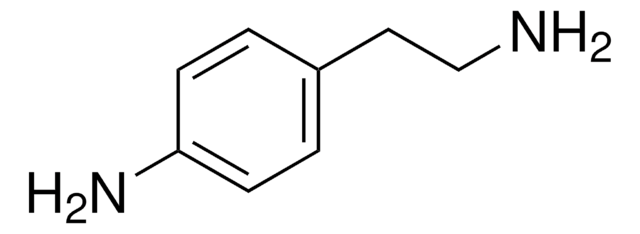D23807
1,3-Diaminopropane dihydrochloride
98%
Synonyme(s) :
1,3-Propanediamine, 1,3-Propanediamine dihydrochloride
About This Item
Produits recommandés
Pureté
98%
Forme
powder
Pf
246-250 °C (lit.)
Chaîne SMILES
Cl[H].Cl[H].NCCCN
InChI
1S/C3H10N2.2ClH/c4-2-1-3-5;;/h1-5H2;2*1H
Clé InChI
HYOCSVGEQMCOGE-UHFFFAOYSA-N
Vous recherchez des produits similaires ? Visite Guide de comparaison des produits
Application
- Tetradentate bis-phosphine ligands (P(2)N(2) and P(2)S(2)) and their Rh(III), Ni(II) and (105)Rh complexes: X-ray crystal structures of trans-[RhCl(2)(L2)]PF(6), [Ni(L2)](PF(6))(2) and μ-O(2)SO(2)-[Ni(L5)](2)(PF(6))(2).: This study explores the synthesis and characterization of tetradentate bis-phosphine ligands and their complexes, demonstrating significant advancements in ligand design and potential applications in catalysis and medicinal chemistry (Cagnolini et al., 2011).
Mention d'avertissement
Danger
Mentions de danger
Classification des risques
Acute Tox. 3 Dermal - Acute Tox. 3 Inhalation - Acute Tox. 3 Oral - Eye Irrit. 2 - Skin Irrit. 2 - STOT SE 3
Organes cibles
Respiratory system
Code de la classe de stockage
6.1C - Combustible acute toxic Cat.3 / toxic compounds or compounds which causing chronic effects
Classe de danger pour l'eau (WGK)
WGK 3
Point d'éclair (°F)
Not applicable
Point d'éclair (°C)
Not applicable
Faites votre choix parmi les versions les plus récentes :
Déjà en possession de ce produit ?
Retrouvez la documentation relative aux produits que vous avez récemment achetés dans la Bibliothèque de documents.
Les clients ont également consulté
Notre équipe de scientifiques dispose d'une expérience dans tous les secteurs de la recherche, notamment en sciences de la vie, science des matériaux, synthèse chimique, chromatographie, analyse et dans de nombreux autres domaines..
Contacter notre Service technique













